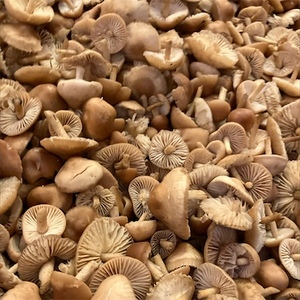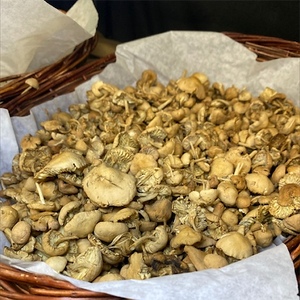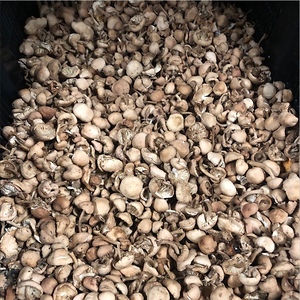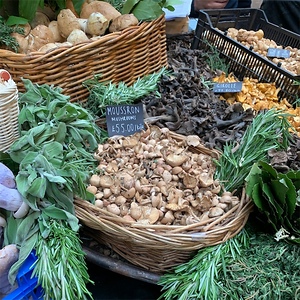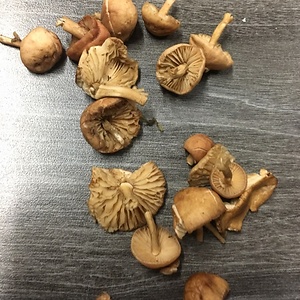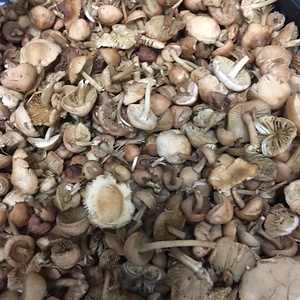


Mousseron Mushrooms
Estimated Inventory, lb : 0
Description/Taste
Mousseron mushrooms are very small in size with caps ranging 2-3 centimeters in diameter and are attached to thin, slender stems. The caps are convex in shape with curled edges when young, flattening out to a bell shape when mature, and range in color from golden brown, brown, to light tan. Underneath the cap, the tightly packed gills are white and are not connected to the skinny, light tan, fibrous stem. When cooked, Mousseron mushrooms are chewy, slightly crunchy, and tender with a spicy-sweet scent similar to cinnamon and a mild, earthy, and nutty flavor.
Seasons/Availability
Mousseron mushrooms are available in the spring in North America and the spring and fall in Europe.
Current Facts
Mousseron mushrooms, botanically classified as Marasmius oreades, are wild, edible mushrooms that are members of the Marasmiaceae family. Also known as a Scotch bonnet, Bonnet mushrooms, Fairy Ring mushroom, and Fairy Ring champigon, Mousseron mushrooms are a soil-dwelling fungus that grows in unique circular shapes known as fairy rings. This shape is due to the underlying mycelium absorbing the nutrients from the grass creating a ring of dead grass with fruiting bodies surrounding the edge. This ring will grow outwardly and keep expanding, sometimes for hundreds of years. Mousseron mushrooms can be found growing in lawns and meadows and are highly prized in Europe for their nutty flavor, versatility, and ability to be dried and rehydrated without the loss of flavor.
Nutritional Value
Mousseron mushrooms contain amino acids, copper, iron, zinc, folic acid, and some antibacterial properties.
Applications
Mousseron mushrooms are best suited for cooked applications such as braising, sautéing, boiling, and frying. Before cooking, these mushrooms must be washed as they are known to be sandy and should be swished in water and drained to remove the small sand granules. Mousseron mushrooms can be cooked for longer periods of time and are typically added to pasta, ragouts, risotto, pizza, omelets, stuffing, soups, stews, and meat dishes. They can also be minced and used to enhance the flavor of cookies or dried and rehydrated when needed for extended use. Mousseron mushrooms pair well with turkey, poultry, pancetta, fava beans, shallot, onion, garlic, chives, tarragon, chervil, thyme, crème Fraiche, dry white wine, beans, and rice. They will keep up to a week when stored in the refrigerator covered with a damp cloth.
Ethnic/Cultural Info
The Mousseron mushroom’s scientific name is derived from the Greek word "Marasmius" meaning decay and "oreades" meaning mountain nymph or fairy in Greek mythology. These mushrooms have been a part of many folklore stories and legends. In Germany, legend states that the rings were the result of witches dancing in circles on the eve of May Day, while others believed the rings were left by lightning strikes or to mark the site of buried treasure. Some Native American tribes in North America believed the rings to be caused by dancing buffalo. Mousseron mushrooms are also sometimes associated with death, which may be linked to their propensity for growing in and around cemeteries. Today the largest fairy ring in the world encircles England’s ancient Stonehenge and is estimated to be a millennium in age. Another ancient circle exists in Canada where the Blackfoot Nation of Alberta call them Kok-a-tos-i-u.
Geography/History
Mousseron mushrooms are native to Europe and North America and have been growing since ancient times. Today these small mushrooms can be found at farmers markets and specialty grocers in the United States, Canada, and throughout Europe.
Recipe Ideas
Recipes that include Mousseron Mushrooms. One
Podcast



